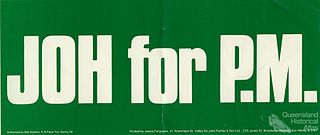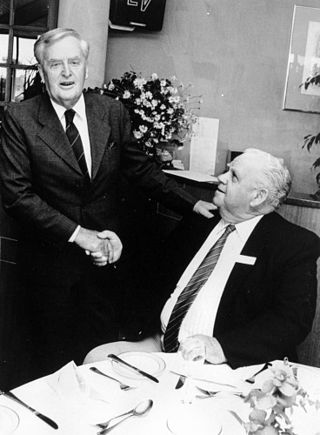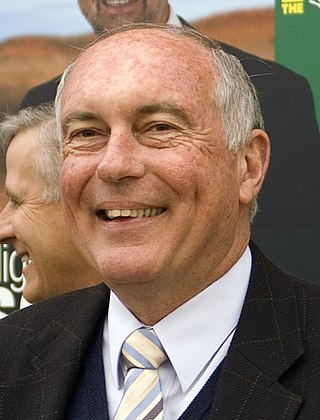Related Research Articles

Sir Johannes Bjelke-Petersen was an Australian politician. He was the longest-serving premier of Queensland, holding office from 1968 to 1987 as state leader of the National Party.

The Joh for Canberra campaign, initially known as the Joh for PM campaign, was an attempt by Queensland National Party premier Sir Joh Bjelke-Petersen to become Prime Minister of Australia. The campaign was announced in January 1987 and drew substantial support from Queensland businessmen and some conservative politicians. The campaign caused a split in the federal Coalition. It did not attract widespread support and collapsed in June 1987. The Australian Labor Party, led by Bob Hawke, went on to win the 1987 federal election with an increased majority, gaining its highest-ever number of seats. Bjelke-Petersen came under increasing scrutiny as the Fitzgerald Inquiry gained traction, and was forced out of politics altogether in December 1987.

Michael John Ahern was an Australian National Party politician who was Premier of Queensland from December 1987 to September 1989. After a long career in the government of Sir Joh Bjelke-Petersen, Ahern became his successor amid the controversy caused by the Fitzgerald Inquiry into official corruption. Ahern's consensus style and political moderation contrasted strongly with Bjelke-Petersen's leadership, but he could not escape the division and strife caused by his predecessor's downfall.

Sir Walter "Wally" Benjamin Campbell, was an Australian judge, administrator and governor. He was the Chief Justice of the Supreme Court of Queensland, Chancellor of the University of Queensland and the 21st Governor of Queensland from 1985 to 1992.

Russell James Hinze was an Australian politician who was a member of the Queensland Legislative Assembly. He presided over an era of controversy that included the setting up of the Racing Development Fund, ministerial re-zonings and the licensing of Jupiters Casino. His career in public life spanned almost four decades, first in local government in the 1950s and 1960s, and then in the Queensland Legislative Assembly from 1966 to 1988. After his exit from Parliament he was charged with eight counts of corruption, but died before going to trial.

The 1989 Queensland state election was held in the Australian state of Queensland on 2 December 1989 to elect the 89 members of the state's Legislative Assembly. This was the first election following the downfall of eight-term premier Sir Joh Bjelke-Petersen at the end of 1987.

This is a list of members of the 45th Legislative Assembly of Queensland from 1986 to 1989, as elected at the 1986 state election held on 1 November 1986.

Elections were held in the Australian state of Queensland on 1 November 1986 to elect the 89 members of the state's Legislative Assembly. It followed a redistribution which increased the number of seats in the Assembly from 82 to 89.

Elections were held in the Australian state of Queensland on 22 October 1983 to elect the 82 members of the state's Legislative Assembly.
Donald Frederick Lane was a Minister of Transport in the Bjelke-Petersen state of Queensland's coalition government. A former policeman in the Special Branch, in 1971 he was elected as the Liberal member for Merthyr, an electorate which included the Fortitude Valley where a lot of the then illegal brothels and casinos were located. During his time with the Police, he had gotten to know Jack Herbert the Chief Organiser of The Joke, and the "Rat Pack" of Terry Lewis, Tony Murphy and Glenn Hallahan well. Following the 1983 Queensland state election he switched to the National Party, providing it with an outright majority, and was rewarded with a ministry. He went on to lead the National Party's submission to the Electoral Commission to more effectively gerrymander and malapportion seats to increase National Party control. It was revealed in the Fitzgerald Inquiry, that Lane had significant unexplained income, and was alleged by Jack Herbert to have taken bribes. Lane did not admit to taking bribes, instead he admitted to abusing Ministerial expenses and claimed a lot of other Ministers had done the same. In the end Lane and three other Bjelke-Petersen ministers were tried in the District Court and sentenced to twelve months imprisonment for falsifying their expense accounts.

William Angus Manson Gunn AM was an Australian politician who represented the Queensland Legislative Assembly seat of Somerset from 1972 until 1992. A member of the National Party, he also served as a Minister and Deputy Premier in various Queensland administrations during the 1980s, and was instrumental in establishing the Fitzgerald Inquiry.
Kevin Rowson "Kev" Lingard is an Australian former politician. He was a National Party member of the Legislative Assembly of Queensland from 1983 to 2009 and a former Deputy Leader of the Nationals in Queensland. Before entering politics, Lingard represented Queensland in both rugby league and rugby union.

The 1988 Barambah state by-election was held on 16 April 1988 to elect the member for Barambah in the Queensland Legislative Assembly, following the resignation of resignation of National MP and former premier Sir Joh Bjelke-Petersen. Until the by-election, the seat had been considered the Nationals' safest seat in Queensland.
The 1989 Queensland state election was held on 2 December 1989.
Colin Charles Lamont was an Australian politician. He was a Liberal Party member of the Legislative Assembly of Queensland from 1974 until 1977, representing the electorate of South Brisbane.
Bruce Edward Bishop was an Australian businessman and politician. He was a Liberal Party member of the Queensland Legislative Assembly from 1977 until 1980, representing the electorate of Surfers Paradise. He was also a prominent member of the Gold Coast City Council during the 1970s.

The National Party of Australia – Queensland (NPA-Q), commonly known as the Queensland Nationals, National Party of Queensland or simply the Nationals, was the Queensland branch of the National Party of Australia (NPA) until 2008. Prior to 1974, it was known as the Country Party. The party was disestablished in 2008, when it merged with the Queensland division of the Liberal Party of Australia to form the Liberal National Party of Queensland (LNP).
This is a list of electoral district results for the 1986 Queensland state election.

The Bjelke-Petersen Ministry was a ministry of the Government of Queensland and was led by Premier Joh Bjelke-Petersen, who led the Country Party and its successor, the National Party. It succeeded the Chalk Ministry on 8 August 1968 as part of a series of events following the death of former Premier Jack Pizzey on 31 July. It was succeeded by the Ahern Ministry on 1 December 1987 following Bjelke-Petersen's resignation as Premier.
The Ahern Ministry was a ministry of the Australian Government of Queensland and was led by National Party Premier Mike Ahern and Deputy Premier Bill Gunn. It succeeded the Bjelke-Petersen Ministry on 1 December 1987 following Joh Bjelke-Petersen's resignation as Premier and from Parliament, and was in turn succeeded by the Cooper Ministry on 25 September 1989, led by Russell Cooper.
References
- ↑ "Australian Political Chronicle: July–December 1988". Australian Journal of Politics and History. 35 (2): 262–263. August 1989. doi:10.1111/j.1467-8497.1989.tb00020.x. ISSN 0004-9522.
- ↑ Roberts, Greg (15 August 1988). "An embittered old warhorse sharpens his political knife for some scalping". Sydney Morning Herald . p. 13.
- ↑ Queensland Legislative Assembly (6 March 1990). Details of polling at general election held on 2 December 1989. p. 68.